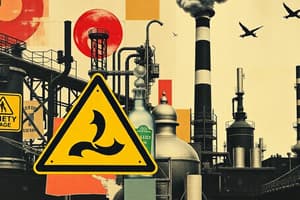Podcast
Questions and Answers
Which hazard analysis technique focuses on the systematic evaluation of potential failures in a system?
Which hazard analysis technique focuses on the systematic evaluation of potential failures in a system?
- Inductive Analysis
- Fault Tree Analysis
- FMEA (correct)
- CMA
What is the main purpose of a permit to work system in safety management?
What is the main purpose of a permit to work system in safety management?
- To authorize specific tasks that may pose risks to health and safety (correct)
- To ensure compliance with hazardous waste regulations
- To maintain safety inventory of all chemicals on site
- To carry out safety audits of manufacturing processes
Which of the following is NOT a part of the Major Accident Hazard control concept?
Which of the following is NOT a part of the Major Accident Hazard control concept?
- Accident investigation reporting
- Financial assessments of accidents (correct)
- Emergency planning at the local government level
- Evaluating major hazards
What does the term 'safety sampling' primarily refer to in the context of plant safety management?
What does the term 'safety sampling' primarily refer to in the context of plant safety management?
Which international standard is specifically related to occupational health and safety management systems?
Which international standard is specifically related to occupational health and safety management systems?
Flashcards
Hazard Identification
Hazard Identification
The process of identifying potential dangers or hazards that could cause harm to people, property, or the environment.
Risk Assessment
Risk Assessment
Evaluating the severity and likelihood of each identified hazard to determine the overall risk level.
Major Accident Hazard
Major Accident Hazard
A hazardous event that could result in serious harm to people, property, or the environment with significant potential for large-scale loss or damage.
Emergency Preparedness
Emergency Preparedness
Signup and view all the flashcards
Safety Inventory System
Safety Inventory System
Signup and view all the flashcards
Study Notes
Plant and Equipment Safety
- Plant safety appraisals and control techniques aim to identify and mitigate potential risks.
- Techniques include plant safety observations, inspections, sampling, and surveys.
- Job safety analysis helps evaluate specific tasks for hazards.
- Safety inventory systems track and manage safety-related resources.
- Product safety focuses on preventing harm from the product itself during operations.
- Permit-to-work systems enforce safety protocols before conducting specific work.
- Safety tag systems use tags to communicate hazards and safety restrictions.
- Loss control minimizes losses due to incidents.
- Damage control and system safety minimize potential harm
- Data-driven safety and incident rate reductions are key objectives.
Laws and Regulations
- Regulations govern various aspects of handling hazardous materials, including storage, import, and manufacture.
- Relevant rules include the Manufacture, Storage, and Import of Hazardous Chemical (Amendment) Rules of 2000.
- Rules also cover chemical accidents (emergency planning), hazardous waste management, and international/national standards.
Hazards and Risks
- Hazard identification techniques include inductive, deductive, Failure Mode and Effects Analysis (FMEA), and Cause Mapping Analysis (CMA).
- Fault tree analysis helps understand the sequence of events leading to an accident.
- Risk assessment techniques prioritize potential hazards and associated risks.
- Measuring and controlling performance is crucial after an accident.
- Techniques exist to measure and control the analysis of hazards.
Major Accident Hazard Control
- Understanding major accident hazards involves evaluating potential impact and consequences.
- Management, local authorities, and the public play critical roles in controlling such hazards.
- On-site and off-site emergency planning is essential and case studies provide valuable guidance.
- Implementation of safety controls and systems needs to be meticulous.
Importance of Disaster Management
- Disaster management entails emergency preparedness at different levels (local to international).
- Contingency plans and emergency plans adhere to international standards like ISO 14001, OHSAS 18001 and OSHA’s Process Safety Management System.
Studying That Suits You
Use AI to generate personalized quizzes and flashcards to suit your learning preferences.




